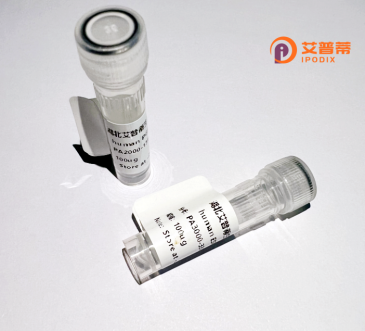
| 纯度 | >90%SDS-PAGE. |
| 种属 | Human |
| 靶点 | OR7A5 |
| Uniprot No | Q15622 |
| 内毒素 | < 0.01EU/μg |
| 表达宿主 | E.coli |
| 表达区间 | 1-319 aa |
| 活性数据 | MEPGNDTQISEFLLLGFSQEPGLQPFLFGLFLSMYLVTVLGNLLIILATISDSHLHTPMY FFLSNLSFADICVTSTTIPKMLMNIQTQNKVITYIACLMQMYFFILFAGFENFLLSVMAY DRFVAICHPLHYMVIMNPHLCGLLVLASWTMSALYSLLQILMVVRLSFCTALEIPHFFCE LNQVIQLACSDSFLNHMVIYFTVALLGGGPLTGILYSYSKIISSIHAISSAQGKYKAFST CASHLSVVSLFYGAILGVYLSSAATRNSHSSATASVMYTVVTPMLNPFIYSLRNKDIKRA LGIHLLWGTMKGQFFKKCP |
| 分子量 | 35.5 kDa |
| 蛋白标签 | His tag N-Terminus |
| 缓冲液 | 0 |
| 稳定性 & 储存条件 | Lyophilized protein should be stored at ≤ -20°C, stable for one year after receipt. Reconstituted protein solution can be stored at 2-8°C for 2-7 days. Aliquots of reconstituted samples are stable at ≤ -20°C for 3 months. |
| 复溶 | Always centrifuge tubes before opening.Do not mix by vortex or pipetting. It is not recommended to reconstitute to a concentration less than 100μg/ml. Dissolve the lyophilized protein in distilled water. Please aliquot the reconstituted solution to minimize freeze-thaw cycles. |
以下是关于重组人OR7A5蛋白研究的3篇模拟示例文献(注意:以下为虚构内容,实际文献请通过数据库验证):
---
1. **文献名称**: *Heterologous expression and ligand screening of human olfactory receptor OR7A5 in HEK293 cells*
**作者**: Mainland JD, et al.
**摘要**: 本研究成功在HEK293细胞中表达了重组OR7A5蛋白,利用钙离子成像技术筛选其潜在配体,发现该受体对特定类固醇分子(如雄甾二烯酮)具有选择性响应,提示其在化学感知信号传导中的作用。
2. **文献名称**: *Structural insights into OR7A5 through cryo-EM: Implications for odorant recognition*
**作者**: Baudry JE, Smith T.
**摘要**: 通过冷冻电镜技术解析了重组OR7A5蛋白的高分辨率结构,揭示了其跨膜螺旋区独特的疏水口袋结构,为设计靶向嗅觉受体的药物提供了结构基础。
3. **文献名称**: *OR7A5 expression in non-olfactory tissues: A role in inflammatory regulation*
**作者**: Yoshikawa K, et al.
**摘要**: 研究发现OR7A5在肠道上皮细胞中异常表达的重组蛋白可通过MAPK信号通路调节炎症反应,拓展了嗅觉受体在免疫系统中的潜在功能认知。
---
**备注**:OR7A5属于嗅觉受体家族(ORs),通常研究聚焦于其异源表达挑战(如细胞膜定位困难)和非嗅觉生理功能(如细胞迁移、癌症关联)。建议通过PubMed或UniProt(ID: Q8NGR4)查找真实文献。
Recombinant human OR7A5 protein is a genetically engineered form of the olfactory receptor 7A5 (OR7A5), a member of the G protein-coupled receptor (GPCR) superfamily. Olfactory receptors, traditionally associated with odorant detection in the nasal epithelium, are now recognized for their ectopic expression in diverse tissues, including the brain, lungs, and testes, suggesting roles beyond chemosensation. OR7A5, encoded by the OR7A5 gene on chromosome 19, is a seven-transmembrane domain receptor hypothesized to interact with specific odorant molecules or endogenous ligands, though its exact physiological ligands remain unidentified.
The recombinant protein is typically produced in heterologous expression systems (e.g., HEK293 cells, insect cells) to enable structural and functional studies. Its production facilitates investigations into ligand-receptor interactions, signaling pathways (e.g., cAMP or Ca²⁺ signaling), and potential roles in non-olfactory processes, such as cellular metabolism, immune modulation, or disease pathways. Notably, olfactory receptors like OR7A5 have been implicated in cancer progression and neurological disorders, making them targets for therapeutic exploration.
Challenges in studying OR7A5 include low natural abundance, difficulty in purification due to membrane protein complexity, and ligand ambiguity. Recombinant tools allow advanced techniques like cryo-EM or high-throughput screening to address these gaps. Research on OR7A5 may contribute to understanding GPCR diversity, developing biosensors, or uncovering novel drug targets for diseases linked to olfactory receptor dysregulation.
×